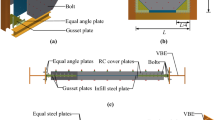Abstract
Global buckling of slender walls, reported only in a few laboratory tests before 2010, became a critical issue in design of reinforced concrete buildings after it was observed following the 2010 Mw 8.8 Chile earthquake and the 2011 Mw 6.3 New Zealand earthquake. Researchers have proposed theoretical buckling models based on prismatic columns subjected to uniform tension/compression cycles, where the key parameters are slenderness ratio, number of curtains of reinforcement, and maximum tensile strain before buckling during load reversal. These models have shown sufficient accuracy in comparison with laboratory tests on columns under such loading conditions. However, buckling in walls is more complex because of variation of strains through the wall depth and variation of moment along the wall height. Nonlinear finite elements are used to evaluate the effects of these more complex loadings on buckling of wall boundary elements. Analyses showed that the maximum tensile strain (averaged over the wall out-of-plane unsupported height) required to buckle the wall during load reversal does not depend on the moment variation along the wall height. Moreover, for typical wall lengths, the wall boundary behaves like an isolated column subjected to axial force cycles, with minimal apparent bracing provided by the wall web. This allows to analyze a broad range of practical cases for buckling susceptibility using simplified approaches based on buckling models of axially loaded columns.



















Similar content being viewed by others
References
American Concrete Institute (ACI) (2019) Building code requirements for structural concrete and commentary. ACI 318-19, Farmington Hills
Applied Technology Council (ATC) (2014) Recommendations for seismic design of reinforced concrete wall buildings based on studies of the 2010 Chile earthquake. ATC-94, Redwood City
Chai YH, Elayer DT (1999) Lateral stability of reinforced concrete columns under axial reversed cyclic tension and compression. ACI Struct J 96(5):780–789
Feenstra PH (1993) Computational aspects of biaxial stress in plain and reinforced concrete. Ph.D. Thesis, TU Delft, The Netherlands
Feenstra PH, De Borst RD, Rots JG (1991a) Numerical study on crack dilatancy part I: models and stability analysis. J Eng Mech 117(4):733–753
Feenstra PH, De Borst R, Rots JG (1991b) A comparison of different crack models applied to plain and reinforced concrete. In: Proceedings, international RILEM/ESIS conference fracture processes in concrete, rock and ceramics, 19–21 June, 1991, Noordwijk, The Netherlands
Filippou FC, Popov EP, Bertero VV (1983) Effects of bond deterioration on hysteretic behavior of reinforced concrete joints. Technical report, EERC 83-19, University of California Berkeley, USA
Goodsir WJ (1985) The design of coupled frame-wall structures for seismic actions. Ph.D. Thesis, University of Canterbury, Christchurch, New Zealand
Kam W, Pampanin S, Elwood K (2011) Seismic performance of reinforced concrete buildings in the 22 February Christchurch (Lyttelton) earthquake. Bull N Z Soc Earthq Eng 44(4):239–278
Mazzoni S, McKenna F, Scott MH, Fenves G (2007) Open system for earthquake engineering simulation: user command-language manual. Pacific Earthquake Engineering Research Center, University of California Berkeley, Berkeley
Oesterle RG, Fiorato AE, Johal LS, Carpenter JE, Russell HG, Corley WG (1976) Earthquake resistant structural walls—tests of isolated walls. Portland Cement Association, Skokie
Parra PF (2015) Stability of reinforced concrete wall boundaries. Ph.D. Thesis, University of California Berkeley, USA
Parra PF, Moehle JP (2014) Lateral buckling in reinforced concrete walls. In: Proceedings, 10th U.S. National Conference on Earthquake Engineering, 21–25 July, 2014, Anchorage, Alaska, USA
Parra PF, Moehle JP (2017) Stability of slender wall boundaries subjected to earthquake loading. ACI Struct J 114(6):1627–1636. https://doi.org/10.14359/516851700836
Paulay T, Priestley M (1993) Stability of ductile structural walls. ACI Struct J 90(4):385–392
Rashid YR (1968) Ultimate strength analysis of prestressed concrete pressure vessels. Nucl Eng Des 7(4):334–344
Rosso A, Almeida JP, Beyer K (2016) Stability of thin reinforced concrete walls under cyclic loads: state-of-the-art and new experimental findings. Bull Earthq Eng 14(2):455–484
Sritharan S, Beyer K, Henry RS, Chai YH, Kowalsky M, Bull D (2014) Understanding poor seismic performance of concrete walls and design implications. Earthq Spectra 30(1):307–334
Taleb R, Tani M, Kono S (2016) Performance of confined boundary regions of RC walls under cyclic reversal loadings. J Adv Concr Technol 14(4):108–124
Thomsen JH, Wallace JW (2004) Displacement-based design of slender reinforced concrete structural walls—experimental verification. ASCE J Struct Eng 130(4):618–630
TNO DIANA (2011) Finite element analysis user’s manual-release 9.4.4, Delf, The Netherlands
Author information
Authors and Affiliations
Corresponding author
Additional information
Publisher's Note
Springer Nature remains neutral with regard to jurisdictional claims in published maps and institutional affiliations.
Rights and permissions
About this article
Cite this article
Parra, P.F., Moehle, J.P. Effects of strain gradients in the onset of global buckling in slender walls due to earthquake loading. Bull Earthquake Eng 18, 3205–3221 (2020). https://doi.org/10.1007/s10518-020-00821-3
Received:
Accepted:
Published:
Issue Date:
DOI: https://doi.org/10.1007/s10518-020-00821-3




